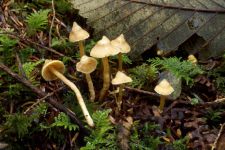Distribution: C. acutus occurs in nutrient-poor conifer forests, often on moist sites in litter, and can be found throughout the north temperate regions.
Conservation Status: Not of concern
The cap is conic to campanulate, pointed, strongly striate, hygrophanous, often fading at its tip first, and the color is light red-brown to yellowish brown fading to yellowish white. The stipe is thin and somewhat fragile and may have a thin coating of white veil fibrils. The edges of the gills are white, slightly ragged, and, microscopically, are covered with balloon-shaped cheilocystidia. The spores are ellipsoid, densely ornamented with fine warts, and 7--8 x 4--5 µm. Smaller specimens of the closely related C. obtusus can be quite hard to distinguish from C. acutus.
Sources: Trudell, Steve and Joe Ammirati. Mushrooms of the Pacific Northwest. Portland, Timber Press, Inc. 2009.
PNW Herbaria: Specimen records of Cortinarius acutus in the Consortium of Pacific Northwest Herbaria database.
CalPhotos: Cortinarius acutus photos.



